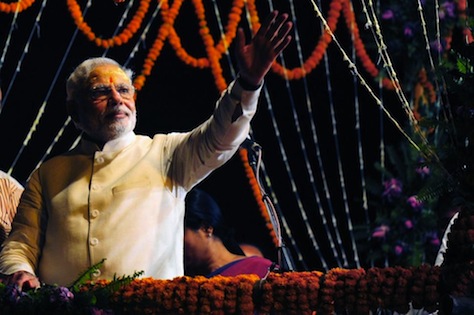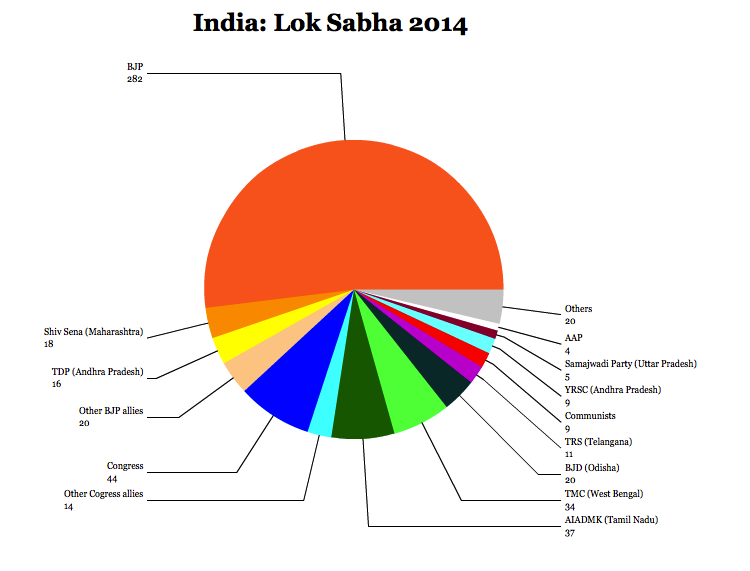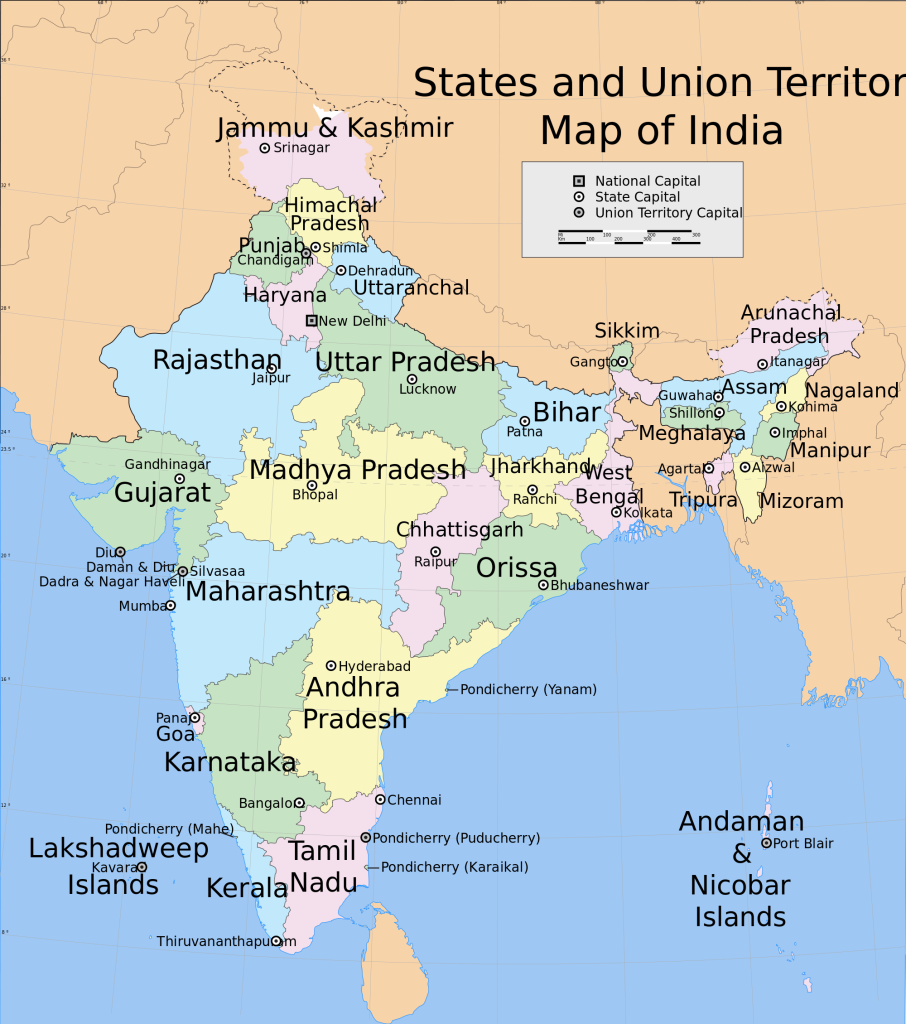
6. India parliamentary elections, expected in May.

In the spring, the country of 1.24 billion people faces a decision — either award a third term to a listless, relatively corrupt center-left government with uninspiring leadership or take a chance on a controversial center-right government that promises economic transformation, but which could inflame India’s Muslim population.
Before May 31, Indians must choose the entire membership of Lok Sabha (लोक सभा), the lower house of India’s parliament — it currently has 545 members, but can have up to a maximum of 552.
On the left is the familiar Indian National Congress (Congress, or भारतीय राष्ट्रीय कांग्रेस). This is the party of Jawaharlal Nehru. And Indira Gandhi, his daughter. And Rajiv Gandhi, her son. And Sonia Gandhi, his Italian-born wife. And now Rahul Gandhi, their son. With 206 seats, Congress is the largest party in the Lok Sabha today, and it leads the United Progressive Alliance, which holds a total of 226 seats.
After a decade in office, India’s first Sikh prime minister, economist Manmohan Singh, will step down no matter who wins the elections — and he’ll do so with an economy in the doldrums and a record of having achieved few of the economic and social reforms that Indians expected when he came to power in 2004. Though he pushed through reforms to liberalize India’s retail sector earlier this year and a law strengthening punishment for rape after the brutal gang rape and murder of a woman in Delhi in December 2012, Singh’s record as prime minister has been panned — much in contrast to his record as finance minister between 1991 and 1996. GDP growth is expected to rise in 2013 to around 5% after falling for three consecutive years — from 10.5% in 2010 to 6.3% in 2011 to just 3.2% in 2012. But that comes after the Indian rupee fell nearly 25% in value against the dollar throughout 2013 — and still remains around 13% lower than it was in January 2013.
Sonia Gandhi, Congress’s party leader throughout Singh’s administration, is expected to continue in that role, with her and her son Rahul (pictured above) leading Congress’s campaign. But Rahul’s relatively lackluster performance on the campaign trail has led some commentators to wonder whether he really cares if Congress wins or loses in 2014. Rahul recently tried to create some distance between himself and Singh, but it remains to be seen whether Rahul has the political skill to become India’s next prime minister.
On the right is the Hindu nationalist Bharatiya Janata Party (the BJP, भारतीय जनता पार्टी), which last held power between 1999 and 2004, when it lost a disastrous ‘India Shining’ campaign that seemed to disregard the majority of Indians who weren’t pocketing the gains of India’s economic boom at the time, despite GDP growth of around 8%. This time around, the BJP has embraced Narendra Modi, the thrice-elected chief minister of Gujarat, home to one of India’s strongest regional economies. He’s popular, not least of which because he’s seen as impervious to corruption, but he hasn’t explained yet how he would translate his Gujarati economic model to the entirety of India. What’s more, he’s plagued by his role in controversial anti-Muslim riots in 2002 that left over 1,000 Muslims dead. Modi’s role remains murky, but it was enough for the United States to deny Modi a visa in the 2000s. It’s a handicap for Modi’s national ambitions, in light of a population of 176 million Muslim Indians who largely mistrust Modi, who got his political start in the Rashtriya Swayamsevak Sangh (RSS), a right-wing, Hindu paramilitary group.
Today, Modi seems like the odds-on favorite to become India’s prime minister, but he and the BJP face challenges. It’s no secret that former BJP leader and deputy prime minister LK Advani has clashed with Modi in the past, and that Modi’s rise to become the nominal head of the BJP remains controversial. What’s more, he starts the campaign with just 117 seats in the Lok Sabha. The second-largest member of the National Democratic Alliance (NDA) coalition, the Janata Dal (United) (जनता दल (यूनाइटेड)), a center-left party with 20 seats that controls India’s third-most populous state, Bihar, when that state’s chief minister Nitish Kumar pulled out of the NDA in June 2013 over differences with Modi.
The BJP thrived in a set of state assembly elections in November and December 2013 in a wide swath of north-central India — it retained Madhya Pradesh (India’s sixth-most populous), retained Chhattisgarh and gained Rajasthan (India’s eight-largest). But it lost its sole foothold in India’s south when it lost control of the government of Karnataka in May 2013. There’s also no indication that the BJP can make inroads in India’s most populous state, Uttar Pradesh, where it placed third in February 2012 state elections behind two UPA-friendly parties, the Samajwadi Party (समाजवादी पार्टी, Socialist Party), which holds 22 seats, and the Bahujan Samaj Party (BSP, बहुजन समाज पार्टी), which holds 21 seats. In West Bengal, India’s fourth-largest state (and one of its poorest), chief minister Mamata Banerjee has a lock on politics after her center-left All India Trinamool Congress (সর্বভারতীয় তৃণমূল কংগ্রেস) took power in 2011, defeating the even more communist Left Front (বাম ফ্রন্ট), which also has a strong influence in Kerala in India’s southwestern corner. Both parties belong to neither the UPA nor the NDA after Banerjee pulled her party out of the UPA in 2012.
Yet another worry is the recent rise of the Aam Aadmi Party (आम आदमी की पार्टी), a new party that rose to prominence in Delhi’s state elections in December and that leads Delhi’s new minority government with outside support from Congress. Whether you think the Aam Aadmi Party marks a cynical brand of populism or an important moment in the fight against corruption in Indian government, its leader (and new Delhi chief minister) Arvind Kejriwal is a suddenly unexpected key player in India’s national elections.
Taken together, it could mean Indians deliver more votes to third parties in 2014 to either Congress or the BJP — but whether they do so in a way that could actually transform Indian governance is less certain.
Photo credit to AFP / Prakash Singh.
NEXT: Colombia
![]()






